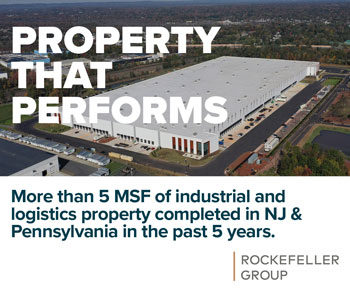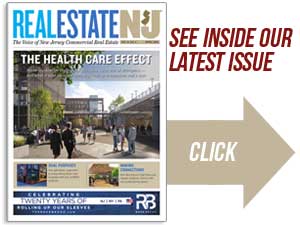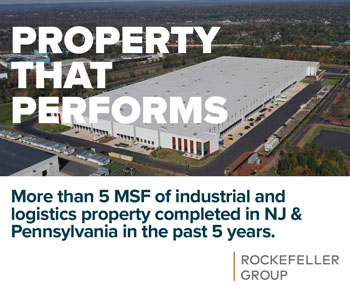David Knee (left) and Robert C. Kossar are vice chairmen with JLL and oversee the firm’s Northeast industrial region. — Photo by Jeffrey Vock for Real Estate NJ
By Joshua Burd
David Knee and his colleagues began to notice it years ago: When industrial tenants with regional distribution needs began to consider both the Exit 8A submarket and the Lehigh Valley, JLL’s brokerage teams in New Jersey and Pennsylvania would both see the requirement, but were unlikely to work together to close the deal.
That has changed with the makeup of JLL’s newly formed Northeast industrial office.
“Today, we are able to look at it so that our clients that are in both of those markets are seeing that we’re communicating better,” said Knee, a vice chairman with JLL. “And if it’s one of our tenant rep clients, we’re able to analyze the market a lot better for them, too, to help them to make that decision.”
It’s just one of the benefits that JLL has achieved since regionalizing its industrial platform in May 2017 under the leadership of Knee and Rob Kossar, who are based in JLL’s East Rutherford office and have established their team as a dominant player in the market. In 2017, JLL completed roughly 43 million square feet of transactions across New Jersey, Pennsylvania and New York, which amounts to more than $2 billion of aggregate real estate value and is split almost evenly between landlord and tenant representation assignments.
“We built the business based on our success in New Jersey,” said Kossar, a vice chairman who also leads JLL’s New Jersey offices. “I think that’s clear and demonstrated … And we wanted to build on that strength, which is why the company turned to us to run the region.”
The East Rutherford team has spent the past year working closely with JLL Executive Managing Director Paul Torosian and Managing Director Larry Maister, who lead the firm’s industrial group in Philadelphia, to integrate the two practices, while looking to penetrate New York City as prospects grow in the outer boroughs. Earlier this year, JLL leased space inside a WeWork facility in the Long Island City section of Queens, where it now has a team of four to serve as its boots on the ground and expects to add two or three more brokers by year-end.
The move follows several other major advances into New York City. JLL also serves as the leasing agent for two highly touted multistory industrial projects in the Red Hook section of Brooklyn and the Bronx, and it has already represented a tenant in a nearly 1 million-square-foot lease at Matrix Development Group’s 200-acre logistics park in Staten Island.
“In the boroughs, there will be companies that are just starting to scratch the surface that are going to be deciding that they need to be there,” Kossar said. “And we’re betting heavily on that by opening up the office, by spending all the time we’re spending on all of these development projects. And we’re very bullish on that opportunity.”
Eight of the firm’s New Jersey-based brokers, including Knee and Kossar, have since become licensed in New York. And the firm expects others to follow suit as it ramps up efforts to canvass the outer boroughs and build its presence organically, Knee said.
All told, the Northeast industrial group has brought on 40 additional professionals in fields such as brokerage, project and development services, property management, research and marketing, bringing its total headcount to 83, JLL said. In the process, Kossar said it has sought to implement the principles that have propelled the growth of the New Jersey practice: collaboration, empowering professionals at all levels, leading with data and having seasoned supply chain logistics professionals within its delivery team for clients.
It’s a far cry from the brokerage model of years past. Knee said that, historically, real estate services firms did not view industrial as a top business line, often because brokers from the office sector, capital markets or other specialties made more money. But he credited JLL for recognizing the viability of its industrial practice, which now accounts for 20 percent of the firm’s U.S. brokerage revenue and is growing at a significant clip.
“Our folks are embracing it, letting us run a business and, I think, are really much more forward-thinking and removing a lot of the barriers, the P and L issues and the layers of management,” Knee said. “So as a broker-led business, we’re on the ground every day, we’re executing, our clients see us and know us, and then our folks are lining up with them at all levels.”
For instance, JLL has varying levels of experience across its industrial group, which Knee said reflects the age diversity among its clients. But the firm has also changed its market research to align with the more regional approach that developers and tenants are taking.
“Some of our clients have helped us actually design how they’d like to see the markets reported because that’s how they’re reporting internally,” Knee said. “So it’s really a partnership with our clients, not only on the agency side, but also on the occupier side. They like seeing the broader scope of services that we’re able to provide.”
Knee said it will be increasingly important for both owners and tenants to have consistent research about the different regions. That is especially true in the boroughs of New York City, for which JLL has now created a dedicated research position.
“We now have one researcher dedicated purely to the boroughs, because if you go into any firm now, what they have is very spotty,” Knee said. “We’re going to make sure we have best-in-class research.”










